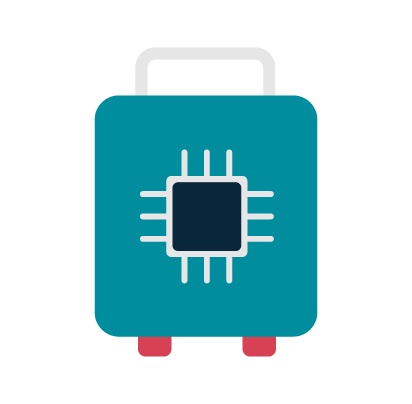


In the face of the COVID-19 health crisis and its many challenges, Mexico’s travel and tourism industry is showing its capacity for reinvention to satisfy traveler expectations. However, there is still a long way to go. Given the current situation, this requires careful strategic planning that still must align with each tourism service providers’ business targets. The first step toward his is listening to the main communities and analyzing their position while identifying and evaluating trends in the conversation and public opinion.
At LLYC, we are developing an analysis of the digital Spanish-language conversation regarding tourism in Mexico that has been taking place throughout the pandemic. This is a far-reaching and timely analysis. Though it is based on the universe of data published on Twitter between February and October 2020, it also considers its relationship to other social media channels, such as Facebook and YouTube. The data, which had a particular focus on local tourism, was processed using artificial intelligence and big data techniques, offering a clear map of the:
- Composition and behavior of communities and entities involved in the conversation.
- Conversation’s main subjects and related issues.
- Relevant communication networks in general.
Based on this map, we can create and adjust communication strategies and even determine whether actions undertaken in 2020 to date have had the desired results. This includes how they impacted the digital conversation, public policies, marketing, institutional relationships, or even the balance of media coverage regarding competitors.
LLYC’s analysis indicates that the digital conversation has a marked, ongoing tendency to politicize the issues related to tourism. More importantly, it helps identify the scope for opportunity in relatively unexplored territories and communities related to the conversation, in which there is ample room for positioning.
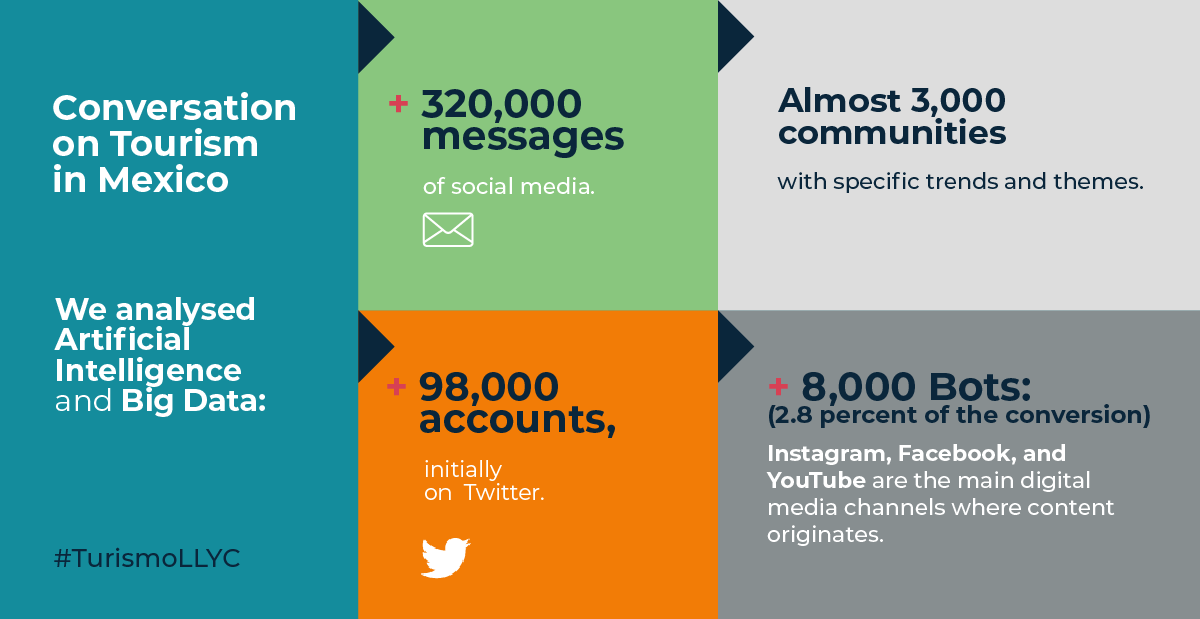
Big data in tourism
Human beings have become machines that produce data and content that we then deposit in a huge cloud of nodes, and without the correct map, we are unable to identify, evaluate, and harness this information. Accordingly, it is important to establish processes to compile data that allow us to trace out strategies of all kinds in an orderly, efficient manner.
Through artificial intelligence algorithms, LLYC has analyzed more than 320,000 messages from 98,000 accounts related to tourism in Mexico. Using this technology, we have optimized the information to obtain the data’s real value in terms of communications. In other words, it allowed us to see what people are talking about, what they are looking for, in which territories and communities they are interacting.
The digital conversation in 2020 has certain unique characteristics. Online communication increased, as it became the most viable way to relate with others. Furthermore, the global agenda was marked by many temporary situations, mainly stemming from the health crisis. Technological tools allowed travelers to close the distance between themselves and countries, destinations, hotels, airlines, and other businesses throughout the whole value chain. Those tourism service providers and sector players that actively listened to digital channels and adapted their communication strategies and relations are those that stayed top of mind.
For example, the study shows that national destinations like the Mexican Caribbean and Jalisco managed to establish a digital community that accounted for 10 and 9 percent of the total conversation, respectively. Their communication strategies became notorious; they used sector leaders, MPs, celebrities, and the media to enhance their messages in a coordinated fashion. However, it is important to remember that their positioning was more closely tied to politics than to their tourism product.
“Based on this map, we can create and adjust communication strategies and even determine whether actions undertaken in 2020 to date have had the desired results”
Digital conversation from February to October
Digital conversation on tourism in this period has been highly heterogeneous, with 2,956 communities, each with specific trends and themes, and which generally do not interact with one another. The only common denominator is the politicization of the subject and the absence of topics related to tourism companies or products, such as hotels, airlines, destination brands, or country brands.
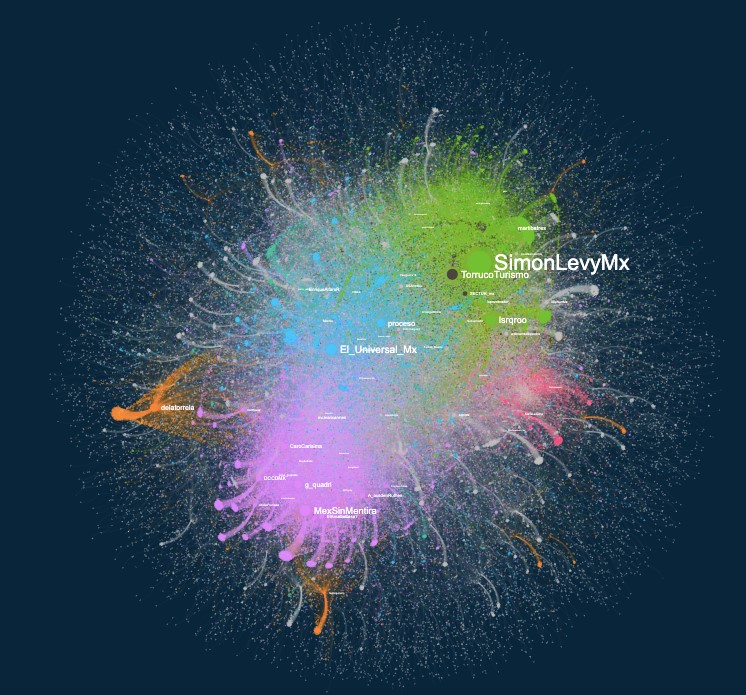
Graph of Global Tourism Community in Mexico in 2020
Phases
1. Pre-pandemic and start of the tourism crisis in Mexico | February to April 2020
128 741 messages – 56 691 accounts
“The digital conversation at the start of the year showed only timid links between tourism and the health crisis. The authorities and tourism service providers gave no sign of the scale of the impact COVID-19 would have on the sector. ”

The digital conversation at the start of the year showed only timid links between tourism and the health crisis. The authorities and tourism service providers gave no sign of the scale of the impact COVID-19 would have on the sector. There was hardly any information being shared on border closures, although some media outlets anticipated the scenario in Mexico given what was happening in Europe. However, this did not resonate deeply in the various communities.
By the end of March, however, the conversation had taken a radical turn. There were discussions on increased cancellations and travel restrictions, as well as health warnings and lockdowns. The conversation started to discuss authorities and the media as well. At that time, tourism companies and service providers distanced themselves from the conversation, acting primarily as spectators.
Uncertainty coexisted with constant criticism of the federal government’s actions. From then on, there was a clear trend of politicization within tourist issues, which has dominated the conversation to date.
2. Peak of the crisis, with staggered destination reopenings | May to July 2020
106 280 messages – 42 918 accounts

Following the implementation of the epidemiological traffic light system in Mexico and the development of health control actions, various destinations around the country began a staggered reopening process. This led to significant conversation regarding state government actions, tourism service provider protocols, and the reinvention of tourism offerings.
At that time, certain voices took a new position in several communities’ conversations. From the point of view of the authorities, it was key to count on digital platforms to communicate the status of the traffic light system and destination reopenings.
This is also when tourism companies began making posts explaining the ways people could travel to and enjoy destinations safely. They also promoted special rates to drive the sector’s reactivation.
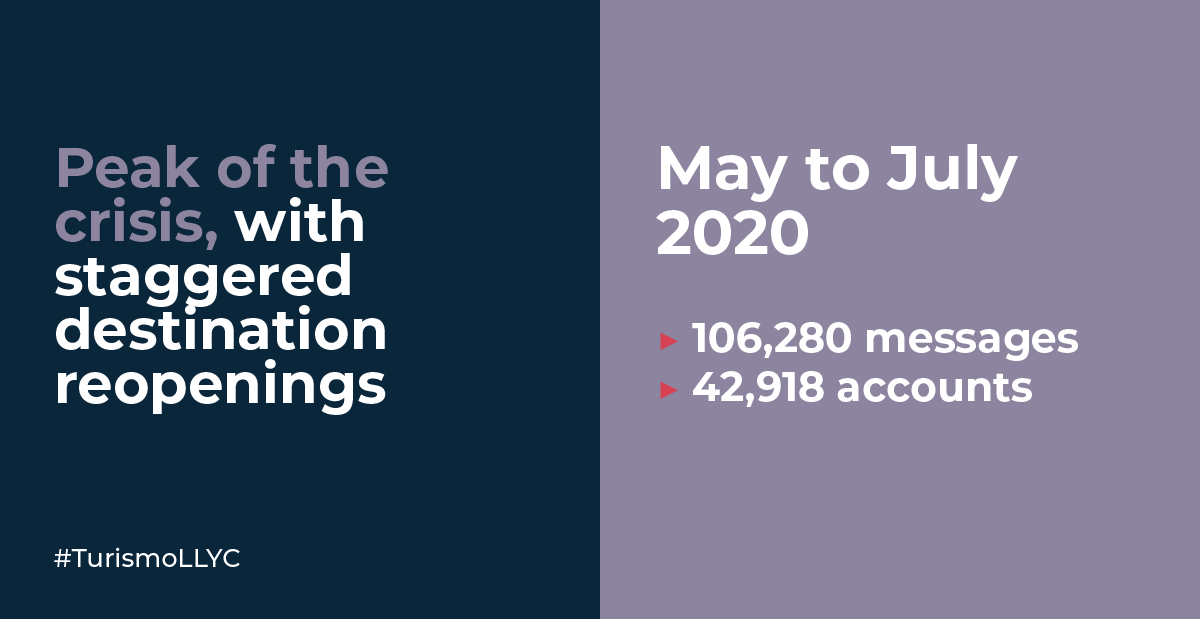
3. The new normal | August to October 2020
99 960 messages – 45 582 accounts

By mid-August, most destinations in Mexico had the right conditions to reactivate their tourist activities. Figures showed a decline in mentions of COVID-19 in the digital tourism ecosystem, but issues related to health and safety in tourism services, the economic recovery, and the financial crisis sectors such as the aviation industry remained on the agenda.
In October, the pandemic moved into a secondary position, with barely 2.5 percent of mentions in identified communities. The tourism conversation during this time focused on the hurricane season and the recovery of destinations. Leading figures, such as the U.S. Ambassador to Mexico, started to share audiovisual materials promoting the country’s tourist offering.
For his part, Federal Tourism Minister Miguel Torruco Marques shifted from a moderate level of participation to being very active in his community’s conversations. The Federal Secretariat of Tourism did the same, and the two shared publications on Mexico’s tourist attractions.
Communities
During this 9-month period, the digital conversation was led by four communities. These generated the largest volume of organic conversation, with some clearly artificial peaks:
- Media community (12 percent of all conversation)
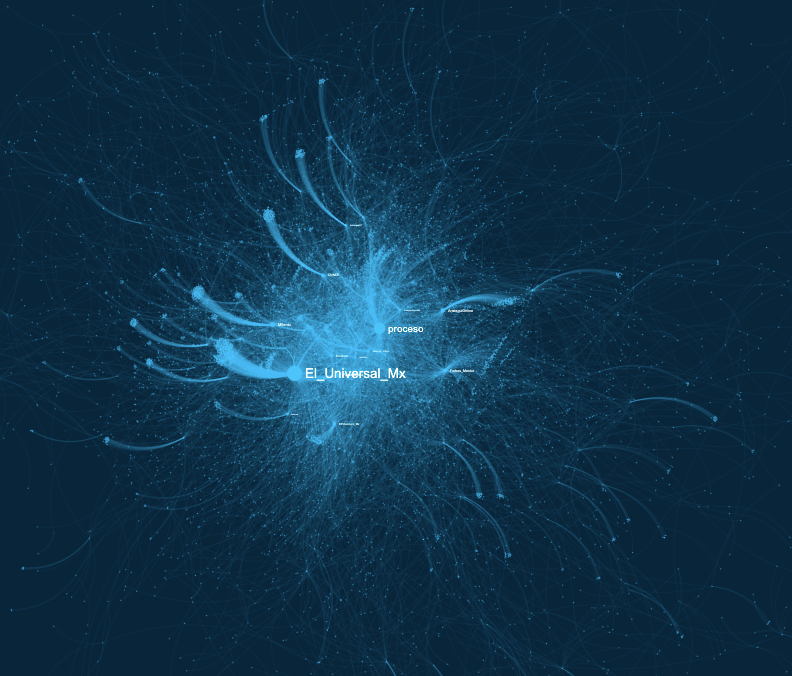
This community functions as the common thread between all digital conversation. It also has greater interaction with other communities, since it monitors public opinion and the issues on the agenda in real time. In this regard, it has driven the conversation at three important times:
- Closures at the start of the lockdown due to the pandemic.
- The partial reopening of some destinations, with news on the constant influx of flights from abroad.
- The reopening phase, new normal, and sector recovery.
In addition, it gave significant coverage to news related to layoffs, violence, and the lack of resources to control the pandemic.
- Community critical of the federal government: (15 percent of all conversation)

Based on the issues on the agenda, a group of opinion leaders (mainly politicians) stood out for their constant criticism of the federal government. This includes complaints regarding specific situations relevant to the tourism reality that affected the country during this time. For example, the situation between Visit México and the Federal Secretariat of Tourism regarding the English translations of the national tourism promotion site, President Andres Manuel Lopez Obrador’s trips on commercial flights, the pandemic’s economic effects on the travel and tourism industry, and the measures implemented to halt the spread of COVID-19, among others.
- Critical and constructive community: (11 percent of all conversation)
“A partir de los temas de agenda, un grupo de líderes de opinión, en su mayoría políticos, destacaron por su crítica constante al gobierno federal e incluyeron a las quejas situaciones particulares sobre la realidad turística que atravesó el país durante esos meses”
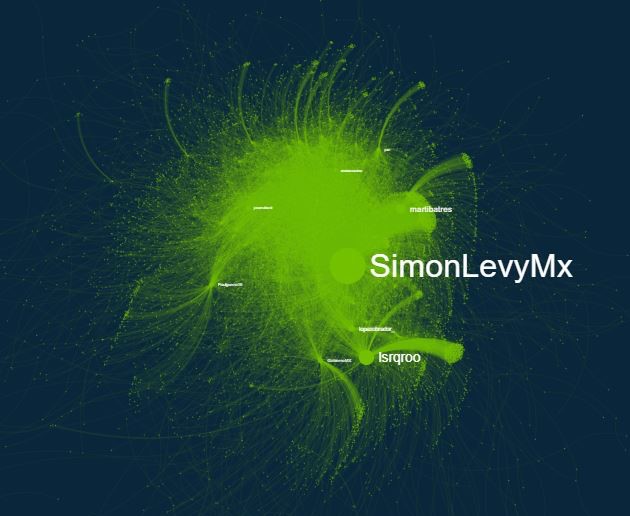
In general, this community has backed the federal government’s actions. However, it continuously criticizes and makes suggestions related to tourism, economic, and entrepreneurship issues. This community sporadically includes politicians and even representative groups from other communities, depending on the agenda at the time.
- Federal government community: (8 percent of all conversation)
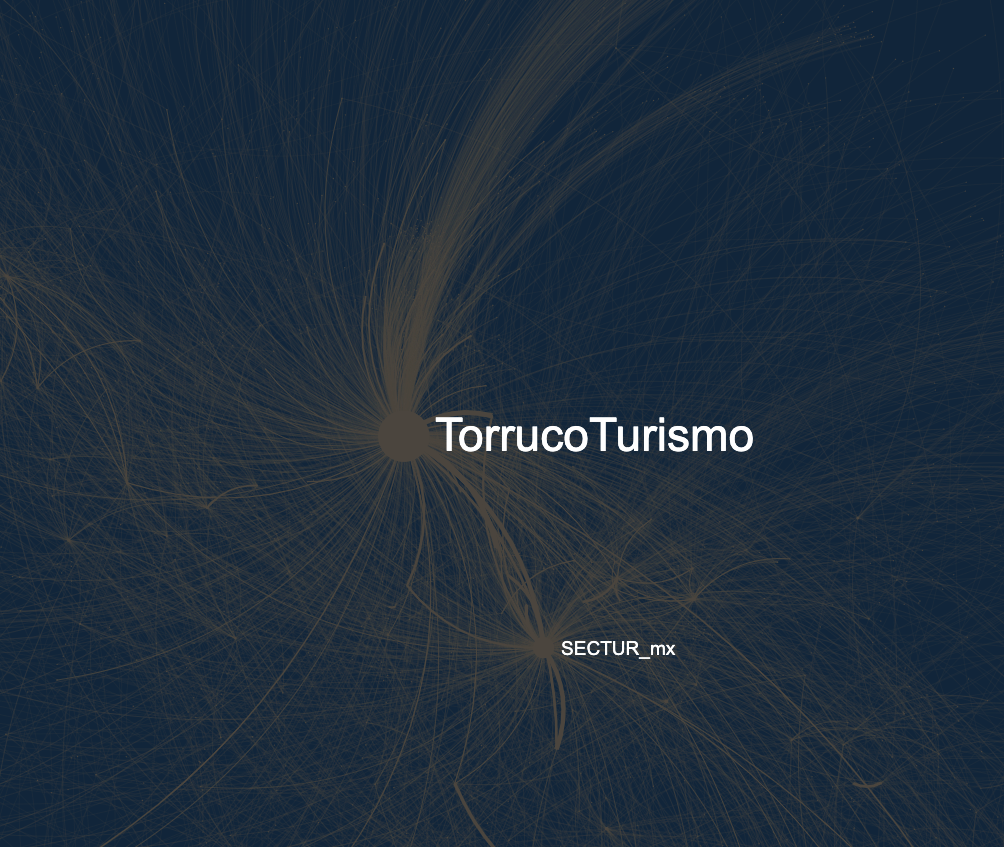
Headed by the Federal Secretariat for Tourism, this community includes State tourism authorities, governors, more neutral media outlets, and business organizations such as CONCANACO. The Federal Secretariat drives the conversation through news releases and the active intervention of Tourism Minister Miguel Torruco Marques. This community is characterized by official, sober communications with little interaction.
There are also other communities that participate in important interactions, which makes them important to mention as well. There is one made up of users sharing how they have lived through the lockdown and criticizing, either directly or humorously, those who have gone on vacation. In addition, another community is focused on the Mexican Caribbean. In it, important politicians such as the State Governor of Quintana Roo and the Mayor of Benito Juarez position the Mayan Riviera and Cancun tourism offerings while maintaining positive conversation regarding the reactivation of the destinations in this region.
Another noteworthy example is the Jalisco community. At the start of the year, State Governor Enrique Alfaro posted highlighting the prohibitions on tourism in his state, particularly the beaches. He used the quédate en casa [stay at home] hashtag, and he has been one of the most active figures to date.
Leading figures
The study on the tourism conversation in Mexico in 2020 also identified the profiles with the largest impact on these digital communities due to their leadership and/or influence on issues related to tourism. These individuals should be taken into account at a strategic level:
- Andres Manuel Lopez Obrador: Despite the Mexican president’s general lack of participation in issues related to tourism, he has spoken out in the media and government-critical communities. He generated peaks in the conversation surrounding the controversy regarding long weekends, the Mayan Train, the disappearance of trusts, and the tourism industry’s recovery.
@lopezobrador_
Bio: Constitutional President of the United Mexican States
Mexico
Followers: 6,770,542
Degree of influence: 968
Communities: 30
- Miguel Torruco Marques: The current Minister of Tourism, he has a leading presence on the internet. He leads the federal government community, but has little influence in other communities. He shares important information on the industry’s recovery and promotes tourist destinations in Mexico
@EnriqueAlfaroR
Bio: Governor of Jalisco. The path to re-founding our state has begun, and together we will make it a reality.
Jalisco, Mexico
Followers: 456,912
Degree of influence: 1,189
Communities: 30
- Enrique Alfaro: The Jalisco state governor’s account has a moderate influence on tourism-related issues, although he is very active. Most of his interactions with various communities are related to the closure of beaches. In recent weeks, he highlighted their reopening and shared news of private initiatives to help reactivate the sector.
@CarlosJoaquin
Bio: State governor of Quintana Roo. [email protected]
Quintana Roo, Mexico
Followers: 81,986
Degree of influence: 494
Communities: 2
- Carlos Joaquin Gonzalez: The Quintana Roo state governor and leader of the Mexican Caribbean community, he is highly influential in his region. He is often picked up by several local media outlets, as well as by Chambers of Commerce and other associations present in the region. He is very active on economic and tourism recovery issues. In general, the tone of his posts and community is very positive.
@CarlosJoaquin
Bio: State governor of Quintana Roo. [email protected]
Quintana Roo, Mexico
Followers: 81,986
Degree of influence: 494
Communities: 2
- Simon Levy-Dabbah: The former undersecretary for Tourist Planning (December 2018 to April 2019) leads the critical and constructive community, where he discusses issues related to free movement on Mexican beaches, the pandemic’s impact on the tourism industry, and other issues, always taking a positive and purposeful attitude toward the authorities. He interacts with other communities, mainly the media, which he quotes as a source and uses as a basis for expressing his opinions.
@SimonLevyMx
Bio: Chief Resilience Officer @wamsonline. Mexican entrepreneur YGL @WEF 2013. Author of @CrecerSinDeuda La Era @Microglobal @LaNeoNao. Zurdo [email protected]
Mexico
Followers: 100,830
Degree of influence: 5,915
Communities: 43
- Maricarmen Cortes: A Mexican columnist and media personality who collaborates with Radio Fórmula, Televisa, and Excelsior, she is a very active participant in political and public life. Regarding tourism, her activity in digital media has been intense during this period, with a main focus on the government-critical community.
@mcmaricarmen
Bio: Host of Fórmula Financiera on @Radio_Formula and of Alebrijes, Águila and Sol on @Televisa. Columnist for Desde el Piso de Remates on @Excélsior
Mexico City
Followers: 81,589
Degree of influence: 1,129
Communities: 33
- Joaquin Lopez Doriga: A journalist with a long track record in the Mexican press, his more than 7 million followers give him a long reach and generally very high impact regardless of topic. His potential should be considered very high, as he communicates in all communities through his large network of followers. This quickly connects him with new trends.
@lopezdoriga
Bio: Journalist #RadioFórmula #TeleFórmula Writes on #Milenio Facebook: http://bit.ly/2JkfU #SoyPuma YouTube, Instagram, Spotify, Telegram: http://t.me/LopezDorigaCom
Mexico City
Followers: 7,565,318
Degree of influence: 63
Communities: 4
- Other participants: Leading media outlets such as El Universal, Milenio, Proceso, Aristegui Noticias, and Forbes México are key participants in these conversations. In addition, associations like the Federation of Tourist Business Owners of Quintana Roo, companies such as Volaris, and hotel owners (which mainly participate through advertising) are important to consider as well.
Hashtags, grouped by relevant issues to the digital conversation
Hashtags are labels that allow content to be identified and grouped together. They are individually generated by subject and community, allowing those participating in the dialogue to join a conversational line in the digital ecosystem. As such, they are very useful for classifying and identifying different subjects’ positions.
The study on the tourism conversation in Mexico in 2020 identified the hashtags used to discuss tourism-related issues most frequently, helping better understand the conversation’s trends. During the period analyzed, these hashtags were primarily employed in a positive manner, with the following standing out as the most popular:
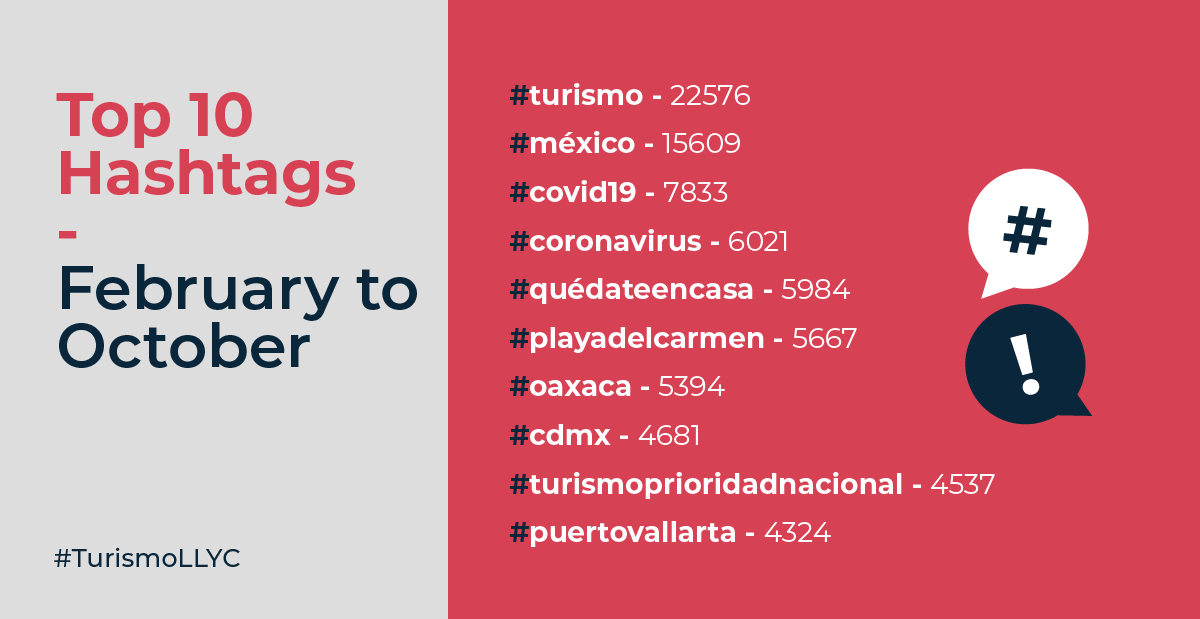
The evolution in how information is grouped into hashtags revealed that, up until September, COVID-19 was the most important issue in the conversation. However, beginning in October, the communities moved on to discussing the reactivation and initiatives promoting the country’s various tourist destinations.
Construct communication strategies based on data
The study revealed eight major findings in the digital conversation on tourism:
- Three important periods stand out in the digital conversation on tourism in Mexico in 2020 (the pandemic’s beginning, crisis peak, and entry into the new normal), leading to the current period. Now, conversation is focused on dialogue related to recovery and adaptability in the new normal.
- This study offers a map of the communities and important figures, providing a guide to the tourism conversation. These findings can even be incorporated into communication strategies for Q4 and early 2021. Certain individuals stand out for their political and/or media presences, because the pandemic required the participation of people who communicated, analyzed, and questioned the health crisis’ impact on tourism on the political and public levels. This has steered efforts and driven the important sector demands that ultimately helped the industry find a way through this period of uncertainty.
- Although the study found marked politicization within the digital conversation, it also identified important spaces that can be occupied and led by those who are, above all, closely linked to positioning the tourism offerings of Mexican destinations, hotels, tour operators, and restaurants, among others.

Sentiment in the conversation on tourism in Mexico in 2020
- The communities and personalities that led the conversation are noteworthy for three key reasons:Sentiment in the conversation on tourism in Mexico in 2020
- Their constant and careful communication of the temporary nature of their interventions.
- Their association with temporary issues and identification of matters of a public interest.
- Their appropriate use of hashtags to group content.
One example of this has been the sector’s call-to-action to federal, state, and local authorities for support for industry members. This was one of the issues that drove interaction between different communities. It was mobilized through a media agenda, which by organizing interviews and webinars, among other activities.
- The role of the media has been outstanding. These profiles continue to position themselves as an informational bridge between communities, as they are the starting point for opinion leaders in publications.
- In recent months, communication from Mexican tourism companies has been more reactive, with few efforts to build digital communities to drive confidence among tourists.
- Through their respective authorities, destinations themselves have taken on a certain leadership role. However, there is an opportunity for other members of the tourism value chain to occupy certain empty spaces. Some of these actors – mainly airlines and hotels – have generated peaks in the conversation through paid advertising, which shows there is community interest that could be capitalized upon through organic content.
- It is important to strengthen the interaction between the different communities that make up the full ecosystem through focused initiatives and the careful positioning of less-politicized profiles that are more focused on promoting tourism. There is a great opportunity for various tourism destinations, companies, and opinion leaders, as some persistent vacuums could still be exploited.
The path to tourism recovery will be long, and the key to its success will be to guarantee a strategic presence in the contemporary world (both digital and physical). This should be based on a systematic understanding of the environment, with help from data digitalization. We now live in an interconnected world that generates billions of datapoints each second as people browse the internet. When these are collected, processed, and analyzed correctly, they provide valuable information that should not be avoided; quite the opposite. It is a fundamental element that can help focus the revival of tourism and all other industries.
12 Important data:
- Bots detected: 8,593 (2.8 percent of the conversion). In general, this is a genuine conversation, carried out by real people and institutions. The bots detected are associated with political efforts.
- Aeroméxico was the most-mentioned brand in the conversation during this period, followed by Interjet and VivaAerobus.
- @promovisionpv and @TeInvitoaOaxaca are the two accounts with the greatest impact and engagement with their followers, posting high quality visual material.
- El Universal is the media outlet with the most messages and interactions, followed by Proceso, Sopitas, and Milenio.
- Gender distribution: 6 percent female, 33.8 percent male, 54.6 percent unknown or institutional/media.
- CDMX, Quintana Roo (Cancun), Jalisco (Vallarta), Guerrero (Acapulco), Oaxaca, and Los Cabos are the locations generating the most messages and interactions.
- 4 percent of messages are shares, 32.6 percent are original posts, and 8 percent are replies or responses.
- Instagram, Facebook, and YouTube are the main digital media channels where content originates.
- Only 7 percent of the accounts in the conversation are verified. This presents an opportunity for tourism companies and their executives to undertake a Twitter verification process in order to gain visibility, build brand confidence, and show an endorsement of the community in general.
- Hotel companies focus their advertising efforts on less politicized channels, such as Instagram and YouTube.
- Business, sports, photos/videos, family, and music are the main interests among the audience discussing tourism. As such, they are subjects that may be very effective to tie tourism content to.
- Performers, executives, and journalists are the people with the greatest influence in the tourism conversation.
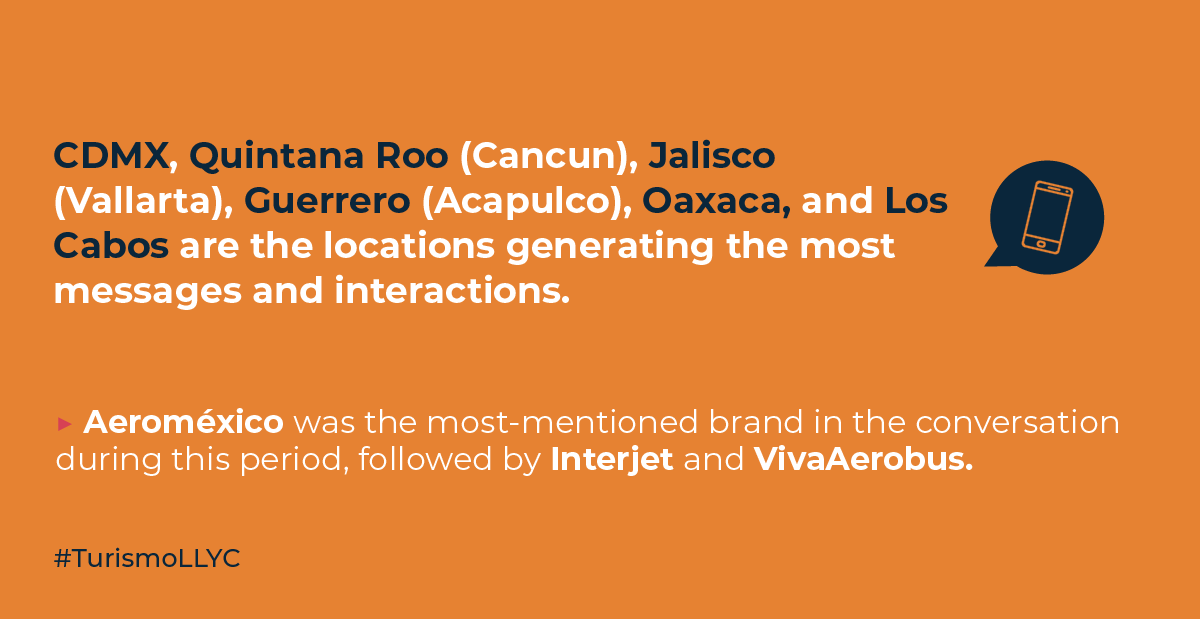
Authors
Anel Hernandez
Agustín Carrillo


